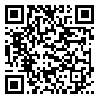Volume 43, Issue 2 (7-2019)
Research in Medicine 2019, 43(2): 71-75 |
Back to browse issues page
, Tavalaee.m@royaninstitute.org
Abstract: (2868 Views)
Backgroundm: Post-acrosomal sheath WW domain binding protein (PAWP) is one of the proteins that
is expressed during spermatogenesis process and has several roles in sperm differentiation, fertilization,
and early embryonic development. The aim of this study was assessment of the relationship between PAWP
expression with fertilization rate in infertile men candidate for intracytoplasmic sperm injection (ICSI). In
addition, sperm DNA fragmentation was also assessed in these infertile men.
Materials and method: In this descriptive study, semen samples were collected from 54 infertile men, of
aged 32.5±4.44 candidate for ICSI referring to Isfahan Fertility and Infertility Center. Sperm parameters,
DNA fragmentation, expression of PAWP at RNA, and protein level were assessed by Computer Assisted
Semen Analysis, TUNEL assay, real time PCR, and western blot, respectively. Data was analyzed by SPSS
(version 16) using Independent t-test and Pearson Correlation. P-values <0.05 were considered statistically
significant.
Resultst: Significant correlations were observed between expression of PAWP at RNA and protein level with
fertilization rate. When infertile men were categorized according to the percentage of fertilization lower and
higher than 50%, the expression of PAWP was significantly lower and percentage of DNA fragmentation was
significantly higher In the first group,in infertile men with fertilization rate lower than 50% compared to with
the other group. (p<0.05).
Conclusion: Normal expression of sperm PAWP at gene and protein levels, and also low percentage of sperm
DNA fragmentation may be considered as normal spermatogenesis processes in men.
is expressed during spermatogenesis process and has several roles in sperm differentiation, fertilization,
and early embryonic development. The aim of this study was assessment of the relationship between PAWP
expression with fertilization rate in infertile men candidate for intracytoplasmic sperm injection (ICSI). In
addition, sperm DNA fragmentation was also assessed in these infertile men.
Materials and method: In this descriptive study, semen samples were collected from 54 infertile men, of
aged 32.5±4.44 candidate for ICSI referring to Isfahan Fertility and Infertility Center. Sperm parameters,
DNA fragmentation, expression of PAWP at RNA, and protein level were assessed by Computer Assisted
Semen Analysis, TUNEL assay, real time PCR, and western blot, respectively. Data was analyzed by SPSS
(version 16) using Independent t-test and Pearson Correlation. P-values <0.05 were considered statistically
significant.
Resultst: Significant correlations were observed between expression of PAWP at RNA and protein level with
fertilization rate. When infertile men were categorized according to the percentage of fertilization lower and
higher than 50%, the expression of PAWP was significantly lower and percentage of DNA fragmentation was
significantly higher In the first group,in infertile men with fertilization rate lower than 50% compared to with
the other group. (p<0.05).
Conclusion: Normal expression of sperm PAWP at gene and protein levels, and also low percentage of sperm
DNA fragmentation may be considered as normal spermatogenesis processes in men.
Type of Study: Original |
Subject:
molecular medicine
Received: 2018/07/31 | Accepted: 2019/02/6 | Published: 2019/07/16
Received: 2018/07/31 | Accepted: 2019/02/6 | Published: 2019/07/16
| Rights and permissions | |
 |
This work is licensed under a Creative Commons Attribution-NonCommercial 4.0 International License. |


